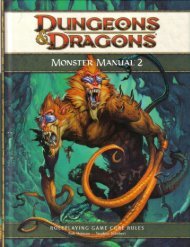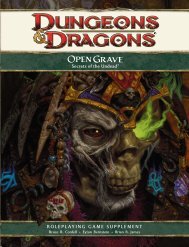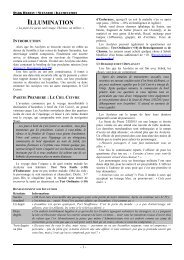Create successful ePaper yourself
Turn your PDF publications into a flip-book with our unique Google optimized e-Paper software.
these prideful, territorial creatures never give in withouta fight unless one wyrm is clearly older and morepowerful than the other.More such clashes occur over <strong>dragons</strong>’ hoards.Every dragon knows that the best place to acquire a lotof wealth quickly is from the lair of another dragon.Although a few <strong>chromatic</strong>s respect their neighbors’domains and would never contemplate such a raid,the majority leap at the chance if they think theystand better-than-average chances of success.Other, less common reasons for conflict exist as well.Chromatic <strong>dragons</strong> war over mates, religious differences,specific treasures, and insults real or imagined.When hostile <strong>dragons</strong> come together, the conflictcan take one of two forms. If combat is not a foregoneconclusion, the <strong>dragons</strong> spend minutes—sometimeseven hours—circling one another, taking each other’smeasure, and perhaps bellowing at one anotheracross the intervening distance. (Usually thesebellows consist of threats and braggadocio, but occasionallytwo <strong>chromatic</strong>s discuss and resolve a point ofcontention in this way.) If one realizes that it cannotprevail in the conflict, it breaks off the engagementand retreats, essentially ceding victory.If the two find themselves evenly matched, andthe shouting back and forth does not result in negotiation,the result is a sudden fury of blood and claw,breath weapon and fang.The usual such battle ends with a clear victor: thedragon that survives. In some instances, however,the loser escapes, with the winner too exhaustedor injured to pursue. In other cases, no clear victoremerges, and the <strong>dragons</strong> break off combat whenboth are too bloodied and exhausted to continue.When this happens, it can mark the start of a longtermrivalry, a grudge match that might be carriedout in skirmishes between minions, sabotage, andespionage that can last for centuries.Still, not all interaction between <strong>chromatic</strong> <strong>dragons</strong>leads to conflict. Some <strong>dragons</strong> band together,despite the racial predilection for solitude. Mostsuch gatherings are familial, but even groups of<strong>dragons</strong> without bonds of blood can find commoncause. Chromatic <strong>dragons</strong> might band together toface encroaching <strong>dragons</strong> more powerful than anyof them as individuals, or they might join forces totake revenge on legendary <strong>dragons</strong>layers. They mightcome together for religious reasons, honoring Tiamator another deity, or they might undertake quests inTiamat’s name. As mentioned previously, a wyrmlingwithout a parent might enter into a master-apprenticerelationship with an elder dragon of the same variety.Finally, sometimes two <strong>chromatic</strong> <strong>dragons</strong> meet totrade information—perhaps on the borders of neighboringbut not overlapping territories—realizing thatas long as they keep off of each other’s lands, they22CHAPTER 1 | Dragon LoreDEVON CADDY-LEE









